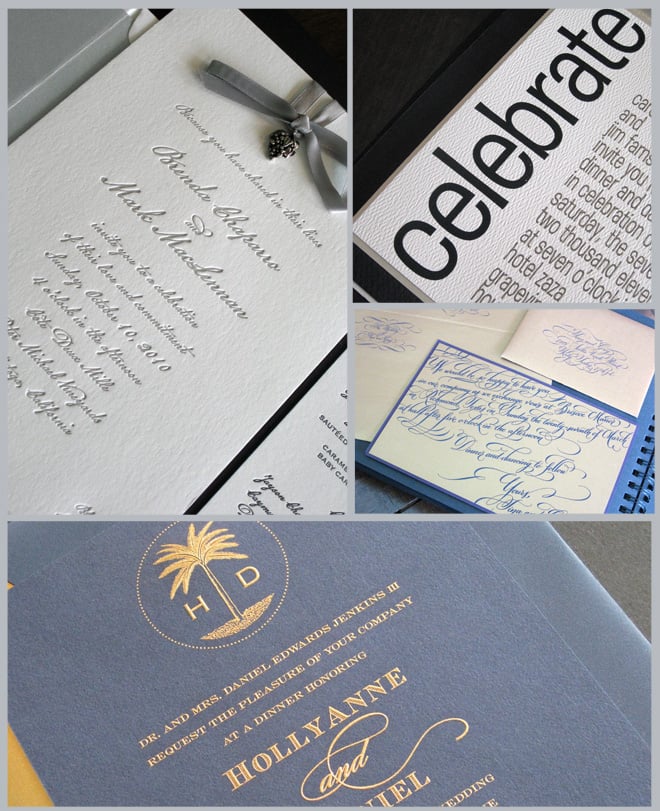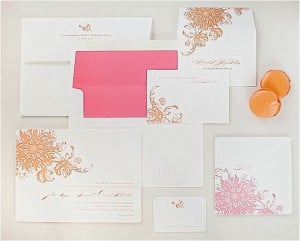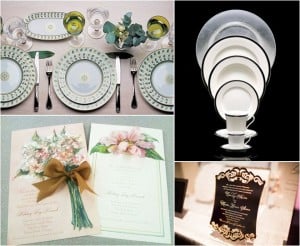
Photos: Katie & Co.
Planning a spring wedding? It’s just about time to start spreading the word. To help guide you through the etiquette, scheduling and infinite style possibilities for your save-the-dates, wedding invitations and other wedding correspondence, we’ve invited renowned Houston invitation designer Katie Hackedorn of Katie & Co. to share her expert advice!
Save-the-Date or Not? Not all weddings require a save-the-date, however more brides are sending them now than ever. That’s because there are now so many creative options for printing, including the advent of digital photography—which makes it possible to use that perfectly adorable pic or from your engagement shoot or other romantic photo on your save-the-date. So even if you’re not planning a destination wedding, or a wedding on a holiday weekend or during a time of year when people may be traveling—traditionally the types of weddings for which save-the-dates were must-sends—you can set the tone and build excitement for your big day when it’s still about six months away.
Dinners & Brunches. Rehearsal dinner and brunch invitations should be sent separately from wedding invitations, as these events are not always hosted by the same people who are hosting the wedding. Often the rehearsal dinner is hosted by the groom’s parents, so the invitation should reflect that. It may have a more masculine feel than the wedding invitation and it may be much less formal. Invitation design is also influenced by the location of the dinner. Same thing goes for the brunch, which is generally a less formal affair and somewhat lighthearted and casual, plus it occurs at a totally different time of day, which affects the look of the invitation.
Looking for creative rehearsal dinner invitation ideas? We once did a beautifully engraved dinner invitation with the groom’s family crest embossed at the top. This signified the importance of family and was a lovely complement to the bride’s family’s wedding invitation. I know that some people feel that separate mailings are wasteful, but really, your wedding invitation deserves to stand on its own and be special, and not overstuffed with other items.
Wedding Invitation Schedule & Etiquette. Wedding invitations should be mailed six to eight weeks before the wedding. The mailing should include the invitation, possibly a reception card and a response set. You can also include a directions or accommodations insert.
I prefer simple straightforward wording, but every bride is different, and often there are circumstances that need to be reflected in the wording. The most reasonable way to indicate whom the invitation is meant for is to address the envelopes accordingly. Not writing “and family” or the children’s names SHOULD be enough. However, there are always those who don’t take note of whom the invitation was actually addressed to and decide to bring whomever they want. You should take note of and address these situations as soon you receive a response card that may have additional names written on it. A polite phone call by the wedding planner or a friend of the bride, saying, “While we would love to have your entire family, we are just unable to accommodate more than…” followed by names of the exact people the invitation was addressed to, should suffice. I don’t think most people realize the cost each uninvited guest adds to the budget until they have been on the planning end of their own event.
And remember, registry information is something that should NOT be included on or sent with the invitation; instead it may be communicated, by parents of the bride and groom or members of the wedding party, to those guests who call or email to inquire about it.
Looking to tap further into Katie’s invitation expertise? Love the look of Katie’s stunning work, pictured right here in this lil’ ol’ blog post? Call her at 713.802.1345 or visit Katie & Co. online!





Very informative post. Inspirational indeed!